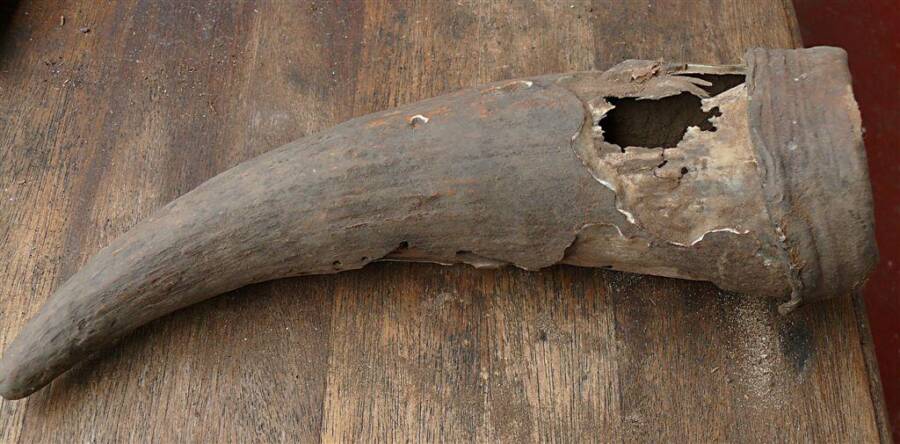In 2020, a hiker exploring a South African cave stumbled across a medicine horn dating back to pre-colonial times — and it was filled with herbal remedies.

Rodger SmithA 500-year-old medicine horn found in South Africa.
In 2020, Rodger Smith and his family were hiking through the South African wilderness when they made an incredible discovery. After setting up camp in La vie D’Antan rock shelter in the Langkloof Mountains, Smith noticed a peculiar horn-shaped object wrapped in leaves and grass. He snapped some photos, and forwarded them to local researchers.
After receiving Smith’s report, researchers at the University of Johannesburg retrieved the object from the cave and got to work identifying it. Now, in a study published in South African Journal of Science, they’ve revealed that Smith had found a 500-year-old medicine horn containing pre-colonial herbal remedies.
Justin Bradfield, the study’s lead author and a professor of archaeology at the University of Johannesburg, said that the horn’s discovery could be monumental to understanding pre-colonial southern Africa. Notably, it marks what may be the first known case of people mixing two or more ingredients to make remedies in the region.
“It’s the first example that we have in southern Africa of tangible evidence that people were mixing different ingredients together to create a medicinal recipe,” Bradfield told Radio France Internationale. “It shows us that people 500 years ago did have a pharmacopeia. They had, within their knowledge systems, knowledge about medicinal compounds and the effects of using certain plants.”
Identifying the horn was a complicated, multi-year process.
The researchers first collected it from the rock dwelling, which was covered in ancient rock art. The team was unable to date the art and could not tell if the horn originated from the same period.
They did, however, discover that the horn had been carefully wrapped in the scales of a poison bulb plant and tightly bound with rope made from grass. According to Radio France Internationale, the horn’s well-preserved state is likely due to the poison bulb’s antiseptic and preservative properties.
The researchers then conducted a chemical analysis of the horn’s contents using gas chromatography-mass spectrometry, and identified a number of herbal compounds.
The most prevalent were mono-methyl inositol and lupeol, compounds commonly found in local plants like the “cancer bush,” so named for its rumored cancer-healing and antioxidant properties. Researchers believe Indigenous people used these plant compounds to treat fevers, heal infections, and control cholesterol and blood sugar, among other remedies.

Rodger Smith Researchers found the horn wrapped tightly in plants and rope made from grass.
According to an article Bradfield wrote for The Conversation, the team carbon dated the medicine horn and estimated that it was used between 1461 to 1630 AD, making it the oldest of its kind found in the region to date.
“To the best of our knowledge, the horn container from La vie D’Antan is the oldest medicine container yet found in southern Africa,” Bradfield told Heritage Daily.
But pinpointing the herbal compounds’ ages proved a more challenging task. Researchers noted that they were unable to date the herbs, meaning it’s possible that the horn is older than its medicinal contents.
Still, researchers determined that the horn likely came from a member of one of two groups that lived in the region around the time the horn was in use: the Khoi, a pastoral herding community, and the San, a group of hunter-gatherers. The intricate and thoughtful wrapping of the horn may speak to its importance to whoever owned it.
“[The wrapping of the horn], very delicate [and] in very specific materials, suggests to us that this was a treasured possession, as I presume any medicine would be in those times,” Bradfield told Radio France Internationale.
He added that whoever owned the medicine container likely left it in the cave intentionally.
“Although we were unable to verify the contemporaneity of the horn and its contents, we consider it unlikely that [Indigenous groups] handed down [the horn] for more than two or three generations,” Bradfield told Heritage Daily. “The parcel seems to have been deliberately placed in the rock shelter with the intention of leaving it there for some time.”
This discovery marks a significant step towards learning more about pre-colonial medical knowledge and tradition from hundreds of years ago. Reflecting on the horn’s discovery, Bradfield wrote:
“[We do not know much] about traditional medicines from the pre-colonial era of southern Africa. What information there is derives mainly from early traveler accounts and modern ethnographic studies. The horn offered us a chance to learn a little more about traditional knowledge of medicine and pharmacology during this early period.”
After reading about the discovery of the 500-year-old medicine horn, learn about the long history of bloodletting as a medical practice. Then, learn about how the Berbers of North Africa survived in the Sahara where no one else could.





